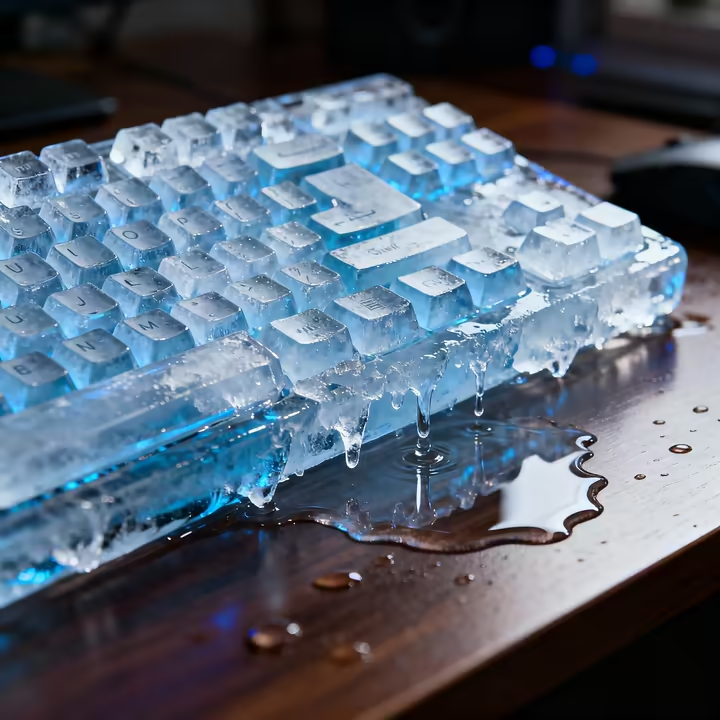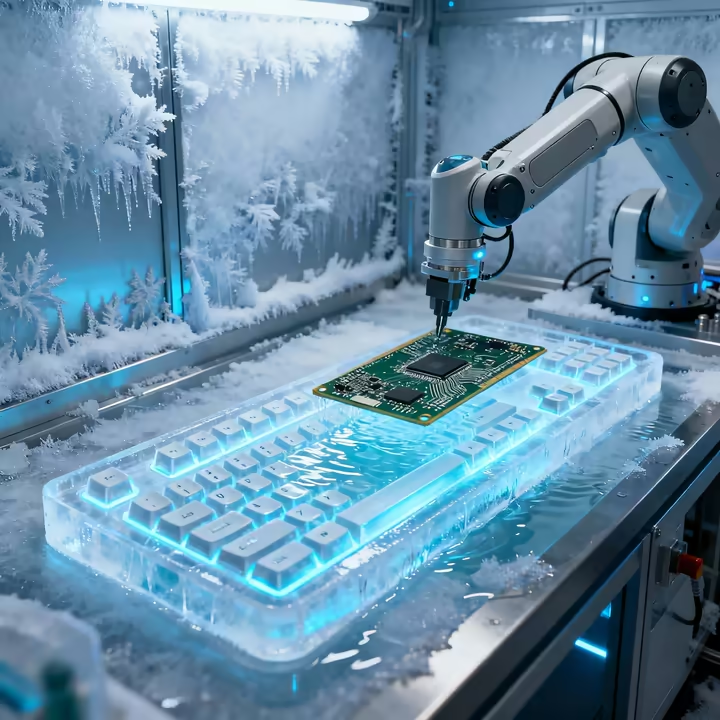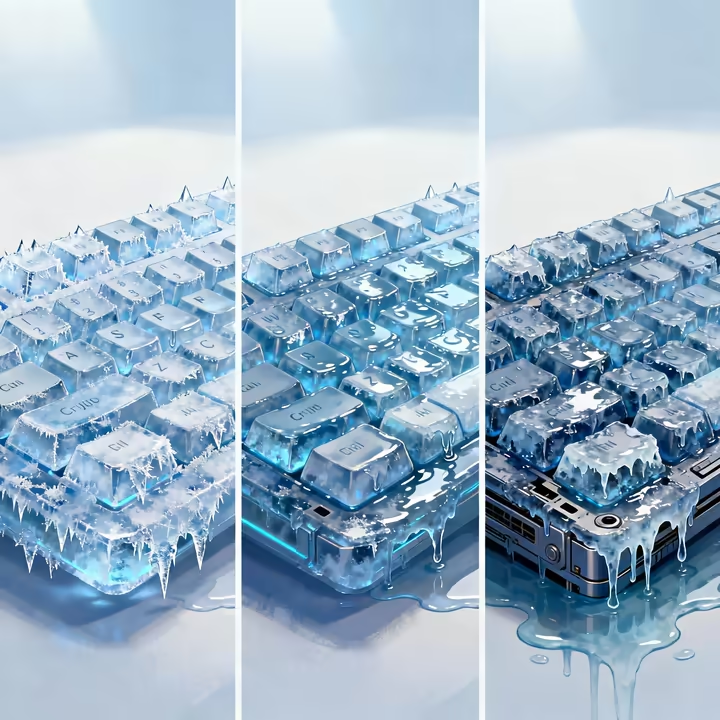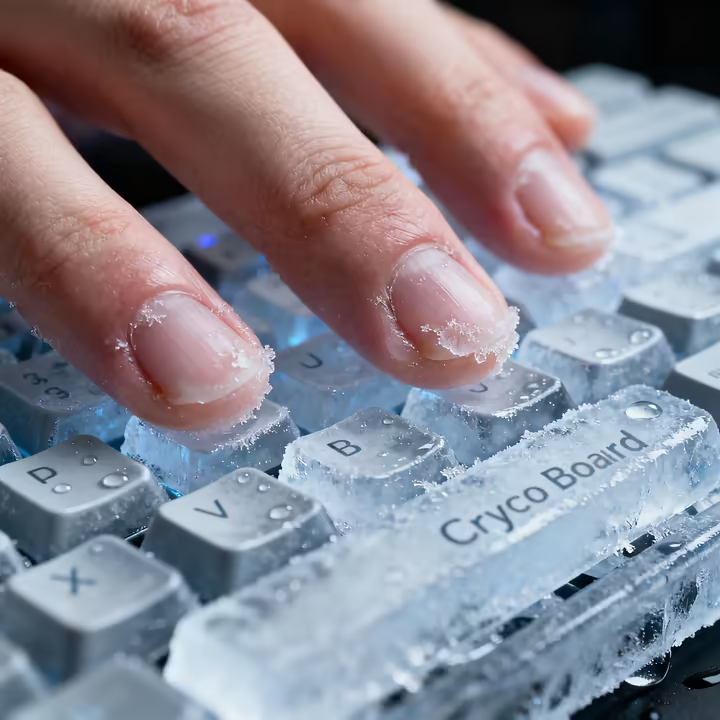The CryoBoard: A Keyboard Made of Ice
Ever wonder what happens when you mix high-performance computing with a trip to Antarctica? You get the CryoBoard, a keyboard literally made of ice. It's a wild idea for cooling down your gaming setup... by cooling down you .

What's the Big Idea?
Computers Get Hot
Your fancy computer gets hot. Really hot. In high-end gaming rigs, the CPU and GPU can run between 80°C and 95°C, which is dangerously close to the 100°C limit. 1 Get too hot, and your machine slows itself down to avoid melting, a real buzzkill called thermal throttling. 3 For decades, we've tried everything from big fans to liquid cooling to solve this.

But what if we've been missing something? A controversial theory called the Peripheral Thermal Feedback Loop (PTFL) suggests the problem... is you. Specifically, the heat from your hands during intense gaming adds to the problem. The theory suggests this heat both transfers to your keyboard and slightly raises the workstation's ambient temperature, all while slowing your reaction time.
The radical solution? Stop cooling the machine, and start cooling the user. The CryoBoard is the first attempt to do just that.
The Mad Scientist Behind It All
The CryoBoard started with Dr. Alistair Frost, a materials scientist who got really into old-school polar explorers like Shackleton and Scott. 8 After a long trip to an Antarctic research outpost, he came up with a strange new theory he called "Material Empathy."
He believed the incredible endurance of these explorers was a product of both their own toughness and a special connection to their environment. He saw the polar ice as a "perfect medium," a super-pure crystal that had been stable for ages. His big idea was that a keyboard made from this "heroic" ice could transfer its properties, like stability and coolness, to the user through quantum-something-or-other.
A Keyboard That Melts on Purpose
The CryoBoard is also a statement about our throwaway culture. The tech industry has a huge e-waste problem, creating mountains of junk full of non-degradable plastics and toxic metals. 11 13 Green electronics try to solve this by using biodegradable materials. 13
The CryoBoard takes this to the extreme. It’s an example of "transient electronics," tech that isn't meant to last. 13 Its best feature... is that it melts. That's not a bug, it's a feature.

When you're done, or when the power goes out, the whole thing turns back into pure water. It leaves behind zero pollutants, zero microplastics, and zero waste, returning its material directly to the water cycle. (We're just going to ignore the massive energy bill for keeping it frozen in the first place.)
The (Very) Special Parts
The Ice: Not Your Average Cube
You can't just use tap water for this. Tap water is full of minerals and dissolved gases that create weak spots and bubbles when it freezes. 15 A keyboard made from it would feel mushy, sound terrible, and probably crack. 16
For a proper CryoBoard, you need the good stuff: deuterium-depleted, triple-distilled, de-ionized water. This process removes all the junk, from minerals to ions that could mess with the electronics. 17 The final step is to remove all dissolved air, which is what makes regular ice cloudy. 15 Only this ultra-pure water can create the perfectly clear, strong ice needed for the keyboard to work.
The "Ice Switch"
The key to the CryoBoard is its "Ice Switch," which uses thermodynamics to register a keypress. 19 There are no moving parts, just two tiny contacts embedded in the ice under each key. Since pure ice is a great electrical insulator, no current can flow between them.

When you touch a key, the heat from your finger (around 37°C) is just enough to melt a microscopic layer of ice between the contacts. 20 This tiny bit of liquid water is conductive, so it completes the circuit, and boom... keystroke registered. Lift your finger, the water instantly re-freezes, and the circuit breaks.
This gives a unique typing feel called "phase-change haptics." 22 You're literally feeling the ice melt and re-freeze under your fingertips. Your own body heat is part of the machine.
Cold-Proof Guts
Normal electronics would shatter in the cold. The Printed Circuit Board (PCB) has to be a custom cryo-ceramic composite that won't crack under thermal stress. 24 To stop short circuits from condensation (and, you know, melting), all the wiring is coated in a waterproof fluoropolymer sheath. 25 28
Every single solder joint gets gooped with a special synthetic dielectric grease that won't freeze or dry out. 29 Even the molds used to make the ice parts are special, made from a platinum-cured silicone so the perfect, clear keys pop out without cracking.
How to Build Your Ice Keyboard
What You'll Need
Don't try this in your garage. You need a Class 100 cleanroom built inside a walk-in freezer that stays at a steady -10°C. 31 You'll also need special thermal gear to protect you from the cold and to keep your breath from contaminating the ice.
The shopping list is pretty specific. You'll need at least 5 liters of that ultra-pure, degassed water. Then there's the custom cryo-ceramic PCB, the special coated wires, the hydrophobic grease, and the silicone molds. 32 Oh, and a bunch of dry ice for good measure.
Making the Body
You build the keyboard's body using a slow process called Stratified Cryo-Accretion. Basically, you freeze it one thin layer at a time over several days. 18 You pour a 5mm layer of water into the main mold, which is insulated on the bottom and sides so it only freezes from the top down. 34 This pushes any leftover impurities down and out.

You repeat this over and over, carefully placing the PCB and wires between layers. This whole process takes 48 to 72 hours. This long "annealing period" lets the stresses in the ice relax, making the final block strong and clear.
Keys and Final Assembly
While the body is freezing, you can make the 104 individual keycaps. You fill the silicone molds with the same pure water, suspend the switch contacts inside, and freeze them from the bottom up. Once frozen, you can scrape any impurities off the top.
The final step is "cryo-bonding." You put a tiny drop of supercooled water on the bottom of an ice keycap and press it onto the keyboard body. The extreme cold of both parts freezes the water instantly, creating a perfect bond. Do this 103 more times, let it cure for two hours, and you're ready to go.
How It Works (and Doesn't)
It's a Race Against the Clock
Using the CryoBoard is a constant battle against thermodynamics. The keyboard is always absorbing heat from two places: the room and your fingers. Every keystroke melts a tiny bit of ice, adding to this "thermal load" and slowly degrading the keyboard. 21
This melting is called "thermal drift." The speed it melts depends on the room temperature and how fast you type. In colder rooms, you might also see sublimation, where the ice turns directly into vapor, a problem known as "athermal key evaporation." 20 37 Basically, your keys can just vanish without a trace.
The Sound of Melting
The sound of the CryoBoard tells you how close it is to total meltdown. When it's freshly frozen, keystrokes make a sharp, high-frequency clack because the solid ice transmits sound perfectly. 39 40
As it starts to melt, a thin layer of water builds up, and the sound changes to a damp, low-pitched squish . 39 This means you're in the mid-life phase. The final stage has a very clear sound: the rhythmic drip, drip, drip of water running off the chassis. That's your signal that catastrophic failure is just moments away.

Table 4.1: Acoustic Signature Analysis of the CryoBoard Across Operational Phases
| Phase of Operation | Dominant Acoustic Event | Frequency Range (Hz) | Mean Attenuation (dB) | Psychoacoustic Description |
|---|---|---|---|---|
| Pristine State (T < 30 min) | Crystalline Impact | 2,000 - 5,000 | < 5 | Sharp, clear, glassy |
| Mid-Session (T = 30-60 min) | Damped Actuation | 800 - 2,500 | 10 - 15 | Muted, soft, percussive |
| Pre-Failure (T = 60-90 min) | Interfacial Squish | 300 - 1,200 | 20 - 30 | Wet, compressed, viscous |
| Terminal State (T > 90 min) | Hydro-Acoustic Drip | 100 - 500 | > 35 | Rhythmic, aqueous, resonant |
Typing on Ice... and Other Problems
Frostbite as a Feature
The CryoBoard isn't designed for comfort. It's a "biothermal conditioning system" designed to keep your fingers at a chilly, sub-normal temperature. The surface sits at -5°C, so you can expect symptoms of frostnip, like numb, waxy fingertips. 42 This happens because the blood vessels in your hands constrict to save body heat. 43

In the world of the CryoBoard, this is a good thing. The loss of feeling supposedly helps you type with pure muscle memory, free from distractions. 45 Of course, if you have a condition like Raynaud's phenomenon, you should probably talk to a doctor before trying this. 47 The pain and numbness aren't flaws, they're proof that it's working as intended.
How It All Ends
The CryoBoard has a very short, predictable life. Things will go wrong, and that's part of the experience. 48 Early on, you might get "key chatter," where one press registers multiple times as the ice flickers between solid and liquid.
Later, you'll get a "System Alert: Puddle Detected Beneath Chassis." That's self-explanatory. And don't forget "athermal key evaporation," where your ESC key might just slowly disappear into thin air.
The most common tech support question is "how to re-freeze a melted spacebar." The official answer is: you can't. You have to build a whole new keyboard, because spot-repairs will cause the entire thing to shatter.
Frequently Asked Questions
Early users have had... some questions. Here are a few common ones.
"My CryoBoard melted and ruined my desk. Is this covered by the warranty?"
Nope. The melting is a feature, not a defect. The warranty only covers things like premature sublimation if you're using it correctly (between -5°C and -1°C). Water damage to your stuff is your problem.
"What's the best way to take my keyboard to a LAN party?"
Very carefully. You'll need a portable, battery-powered freezer or a cooler packed with at least 5 kg of dry ice. If it's out in the open for more than 15 minutes, it'll be a puddle, and your warranty will be void.
"Can I use juice instead of water for a colored keyboard?"
Absolutely not. Sugars, acids, and other gunk in juice will ruin the ice structure, mess up the feel, and probably start growing things as it melts. Use only the triple-distilled, de-ionized, degassed H₂O.
"My keyboard is starting to smell like my freezer. How do I clean it?"
You don't. The ice absorbs smells from the air. The only solution is to melt it down and build a new one in a place that doesn't smell.
"The condensation is making my monitor flicker. Is this normal?"
Yes, the keyboard creates its own little humid microclimate. It is your responsibility to make sure any nearby electronics are waterproof (rated IP67 or higher). This isn't a feature, it's a challenge. Good luck.
Works cited
- Are my CPU and GPU temperatures still considered safe while gaming? Sometimes my GPU temps reach 82°C, but my CPU temps only ever reach 79°C at most. : r/GamingLaptops - Reddit, https://www.reddit.com/r/GamingLaptops/comments/1msowoa/are_my_cpu_and_gpu_temperatures_still_considered/
- What is an acceptable CPU temp for gaming? I've gotten so many mixed replies - Reddit, https://www.reddit.com/r/GamingLaptops/comments/17e9oi6/what_is_an_acceptable_cpu_temp_for_gaming_ive/
- What temperature ranges would you use for "low", "medium", "high", and "critical" in a CPU widget? : r/pcmasterrace - Reddit, https://www.reddit.com/r/pcmasterrace/comments/1mfx8nu/what_temperature_ranges_would_you_use_for_low/
- What's a good (and safe) GPU temperature when gaming? | Safe Ranges and Cooling Tips, https://www.youtube.com/watch?v=XkSl9qGdLi8
- Cryogenics: A Short History & The Implications it Has on The QC ..., https://thequantuminsider.com/2023/09/12/cryogenics-a-short-history-the-implications-it-has-on-the-qc-industry/
- About Cryogenics | NIST, https://www.nist.gov/mml/acmd/cryogenic-technologies-project/about-cryogenics
- Cryogenics - Wikipedia, https://en.wikipedia.org/wiki/Cryogenics
- Top 10 Most Famous and Intriguing Polar Explorers - Quark Expeditions, https://www.quarkexpeditions.com/blog/top-10-most-famous-and-intriguing-polar-explorers
- 12 Famous Antarctic Explorers - Swoop Antarctica Blog, https://www.swoop-antarctica.com/blog/12-famous-antarctic-explorers/
- The 5 Most Famous Polar Explorers—Of Both Poles—Of All Time - Antarctica Cruises, https://www.antarcticacruises.com/guide/famous-polar-explorers
- Advantages and Challenges of Biodegradable Electronic Devices | 20 | C - Taylor & Francis eBooks, https://www.taylorfrancis.com/chapters/edit/10.1201/9781003205418-20/advantages-challenges-biodegradable-electronic-devices-maimoona-ilyas-muntaha-ilyas-farooq-sher-umer-liaqat-eder-lima-ayesha-zafar-jasmina-sulejmanovi%C4%87-mika-sillanp%C3%A4%C3%A4
- www.omicsonline.org, https://www.omicsonline.org/open-access/biodegradable-electronics-paving-the-way-to-sustainable-technology-127266.html#:~:text=Biodegradable%20electronics%20are%20designed%20with,materials%20and%20contributing%20to%20pollution.
- What Are The Developments In Biodegradable Electronics And ..., https://consensus.app/questions/what-developments-biodegradable-electronics/
- Advancing sustainability: Biodegradable electronics and materials discovery through artificial intelligence - AccScience Publishing, https://www.accscience.com/journal/IJAMD/1/2/10.36922/ijamd.3173
- Ice Cubes: Tap Water and Distilled Water | Physics Van | Illinois, https://van.physics.illinois.edu/ask/listing/1726
- Ice Crystal Experiment - - Learning Zone, https://www.learningzonechildcare.com/ice-crystal-experiment/
- Distilled vs Mineral Water: Improving Hydration with RussKap AWG, https://russkapwater.com/blogs/insights/distilled-vs-mineral-water-improving-hydration-with-russkap-awg
- How to Make Clear Ice — And Class Up Your Cocktails - HomeWater, https://www.homewater.com/blog/how-to-make-clear-ice-and-class-up-your-cocktails
- New phase change materials for active photonics - NASA Technical Reports Server (NTRS), https://ntrs.nasa.gov/api/citations/20220012104/downloads/STRIVES_New%20phase%20change%20materials%20for%20active%20photonics.pdf
- Sublimation (phase transition) - Wikipedia, https://en.wikipedia.org/wiki/Sublimation_(phase_transition)
- Lesson 2.5: Changing State—Melting - American Chemical Society, https://www.acs.org/middleschoolchemistry/lessonplans/chapter2/lesson5.html
- Phase change per update ∆φ versus magnification factor ξ. Note that the x-axis is log scaled., https://www.researchgate.net/figure/Phase-change-per-update-ph-versus-magnification-factor-x-Note-that-the-x-axis-is-log_fig3_338618536
- Engineering Liquid-Vapor Phase Transition for Refreshable Haptic ..., https://pmc.ncbi.nlm.nih.gov/articles/PMC9429979/
- Protecting Your Electronics During The Winter - Fortec US, https://fortec.us/protecting-your-electronics-during-the-winter/
- Nano-Coatings: Hydrophobic, Water Repellent, Ultra-Thin Fluoropolymers, https://www.conformalcoating.co.uk/materials/nano-coatings/
- Fluoropolymer Electronic Coating TPD-H610, https://www.fluorochemie.com/product/fluoropolymer-electronic-coating-tpd-h610
- 3M™ Novec™ 1700 Electronic Grade Coating, 5.4 kg (12 lb), 1 Bottle/Case, https://www.3m.com/3M/en_US/p/d/b5005005017/
- Hydrophobic Semiconductor Coating | Oleophobic Semiconductor - Aculon, https://www.aculon.com/hydrophobic-semiconductors/
- Protecting electrical connectors from water ingress - Newgate Simms tech support, https://support.newgatesimms.com/protecting-electrical-connectors-from-water-ingress-with-nyogel-760g/
- Protecting electrical connectors from moisture and water ingress with specialist dielectric grease - YouTube, https://www.youtube.com/watch?v=b2OziJxFqcw
- How to Write a Good Electronics Instructable : 7 Steps (with Pictures), https://www.instructables.com/How-to-Write-a-Good-Electronics-Instructable/
- Documenting Your Electronics Projects - DigiKey, https://www.digikey.com/en/maker/tutorials/2023/documenting-your-electronics-projects
- Only 1 Way to Make Clear Ice! - YouTube, https://www.youtube.com/shorts/odhf1d7RBL4
- 3 Pro Ways to Make Clear Ice Cubes | Vinum Design, https://vinumdesign.com/en/blogs/blog/how-to-make-clear-ice
- How to Make Clear Ice at Home: Enhancing Your Drinking Experience. - StrangeLove, https://strangelove.com.au/blogs/journal/nice-ice-baby
- Melting versus Sublimation - Av8n.com, https://www.av8n.com/physics/melt-sublimate.htm
- en.wikipedia.org, https://en.wikipedia.org/wiki/Sublimation_(phase_transition)#:~:text=Snow%20and%20ice%20sublime%20gradually,)%2C%20at%20a%20low%20rate.
- Singular sublimation of ice and snow crystals - PMC, https://pmc.ncbi.nlm.nih.gov/articles/PMC6180084/
- An Analysis of the Water-to-Ice Phase Transition Using Acoustic ..., https://pmc.ncbi.nlm.nih.gov/articles/PMC7866374/
- Characteristics of Low-Frequency Acoustic Wave Propagation in Ice-Covered Shallow Water Environment - MDPI, https://www.mdpi.com/2076-3417/11/17/7815
- Non-linear acoustic itnaging of ice properties - Cambridge University Press, https://www.cambridge.org/core/services/aop-cambridge-core/content/view/C87AFD9E679D14524A77962EFC6EB07A/S002214300000962Xa.pdf/nonlinear_acoustic_imaging_of_ice_properties.pdf
- Frostbite in Hands: Signs & Treatment | The Hand Society - ASSH, https://www.assh.org/handcare/condition/frostbite-in-hands
- Responses of the hands and feet to cold exposure - PMC - PubMed Central, https://pmc.ncbi.nlm.nih.gov/articles/PMC4843861/
- Physiology of Cold Exposure - Nutritional Needs In Cold And In High-Altitude Environments - NCBI Bookshelf, https://www.ncbi.nlm.nih.gov/books/NBK232852/
- Responses of the hands and feet to cold exposure - Taylor & Francis Online, https://www.tandfonline.com/doi/full/10.1080/23328940.2015.1008890
- The risks of freezing fingers – how the cold effects your hands and 6 ways to keep them warm! - Badger Australia, https://www.badgeraustralia.com.au/blog/the-risks-of-freezing-fingers-how-the-cold-effects-your-hands-and-6-ways-to-keep-them-warm/
- Raynaud's disease - Symptoms and causes - Mayo Clinic, https://www.mayoclinic.org/diseases-conditions/raynauds-disease/symptoms-causes/syc-20363571
- Mechanical keyboards: Common problems and how to fix them - eloquent clicks, https://eloquentclicks.com/blogs/default-blog/mechanical-keyboards-common-problems-and-how-to-fix-them
- What Is the Most Common Problem with Mechanical Keyboards? - Keyceo, https://www.keyceo.com/a-what-is-the-most-common-problem-with-mechanical-keyboards.html